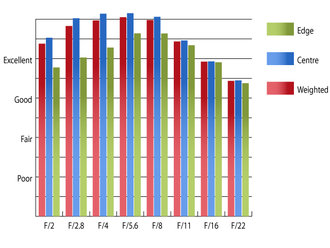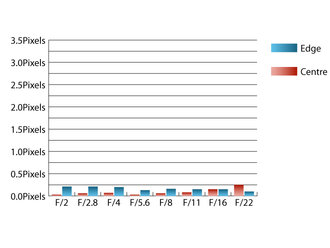Carl Zeiss Apo-Sonnar T* 135mm f/2 Review
Carl Zeiss Apo-Sonnar T* 135mm f/2 Performance
Sharpness is already outstanding in the centre of the frame at maximum aperture, and approaching excellent levels of clarity towards the edges of the frame. Stopping down improves sharpness further across the frame, reaching excellent levels towards the edges of the frame by f/2.8 and outstanding levels of sharpness between f/5.6 and f/8. You couldn't really ask for more as far as sharpness is concerned.  MTF at 135mm | How to read our chartsThe blue column represents readings from the centre of the picture frame at the various apertures and the green is from the edges. Averaging them out gives the red weighted column.The scale on the left side is an indication of actual image resolution. The taller the column, the better the lens performance. Simple. For this review, the lens was tested on a Nikon D600 using Imatest. |
Chromatic aberrations are virtually non-existent across the frame at all apertures. Imatest was able to detect fringing covering 0.21 pixel widths towards the edges of the frame at f/2, but you will be hard pressed to notice this yourself.
 CA at 135mm | How to read our chartsChromatic aberration is the lens' inability to focus on the sensor or film all colours of visible light at the same point. Severe chromatic aberration gives a noticeable fringing or a halo effect around sharp edges within the picture. It can be cured in software.Apochromatic lenses have special lens elements (aspheric, extra-low dispersion etc) to minimize the problem, hence they usually cost more. For this review, the lens was tested on a Nikon D600 using Imatest. |
Falloff of illumination towards the corners of the frame is reasonably well controlled for a lens with such a fast maximum aperture. At f/2 the corners of the frame are 1.96 stops darker than the image centre and visually uniform illumination is achieved with the aperture stopped down to f/4 or beyond.
Distortion is so mild that you'll struggle to spot any, even in images with straight lines parallel to the edge of the frame. Imatest did manage to detect 0.21% barrel distortion, which is an incredibly small amount.
Contrast is high and flare is rarely an issue, even when shooting into the light. The deep circular hood does an excellent job of shading the lens, and protecting the front element from impact.
Add your message
Login required
Please login here or if you've not registered, you can register here. Registering is safe, quick and free.
Please login here or if you've not registered, you can register here. Registering is safe, quick and free.
photodo Stats
1102 lenses
428 MTF tests
74 in-depth photodo reviews
100+ users join each day
Help the lens community by reviewing or rating a lens today via our lens search
428 MTF tests
74 in-depth photodo reviews
100+ users join each day
Help the lens community by reviewing or rating a lens today via our lens search
Latest Lens Reviews
- Chinon 28mm f/2.8 Vintage Lens Review
- Canon EF 70-200mm f/4L IS II USM Lens Review
- Samyang AF 85mm f/1.4 EF Review
- Sigma 70mm f/2.8 DG Macro Art Review
- Samyang AF 24mm f/2.8 FE Review
- Meike 50mm f/1.7 Review
- Tamron 70-210mm f/4 Di VC USD Review
- Lensbaby Burnside 35mm f/2.8 Review
- Asahi Super Takumar 50mm f/1.4 Review
- Asahi Super-Multi-Coated Takumar 135mm f/3.5 Review
